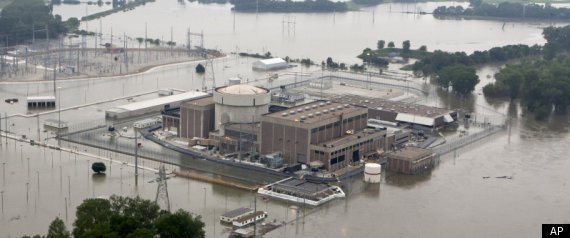– Fort Calhoun Nuclear Plant: Flood Seeps Into Turbine Building At Nebraska Nuke Station (Huffington Post, June 27, 2011):
OMAHA — Missouri River floodwater seeped into the turbine building at a nuclear power plant near Omaha on Monday, but plant officials said the seepage was expected and posed no safety risk because the building contains no nuclear material.
An 8-foot-tall, water-filled temporary berm protecting the plant collapsed early Sunday. Vendor workers were at the plant Monday to determine whether the 2,000 foot berm can be repaired.
Omaha Public Power District spokesman Jeff Hanson said pumps were handling the problem at the Fort Calhoun Nuclear Station and that “everything is secure and safe.” The plant, about 20 miles north of Omaha, has been closed for refueling since April. Hanson said the berm’s collapse didn’t affect the shutdown or the spent fuel pool cooling.
Nuclear Regulatory Commission spokesman Victor Dricks described the situation as stable. NRC Chairman Gregory Jaczko plans to inspect the Fort Calhoun plant on Monday as part of a pre-arranged visit to Nebraska.
Hanson said OPPD fired up generators and cut the power supply after water surrounded the main electrical transformers on Sunday. The generators powered the plant until an off-site power supply was connected later in the day.
Officials said the berm wasn’t critical to protecting the plant, which sits across the river from Iowa.
“There are other structures and systems in place that can ensure they will continue operating safely,” Jaczko said Sunday.
The river was not expected to rise higher than the level the plant is designed to handle.
Jackzo inspected the Cooper Nuclear Station, which sits on the Missouri River about 75 miles south of Omaha, on Sunday. He asked plant officials and the NRC’s local inspectors questions about the plant and this year’s flooding.
The plant, which is owned by Nebraska Public Power District, remains dry because it sits at an elevation above the river and continues to operate at full capacity. The base of Cooper and its storage area for used nuclear fuel is 903 feet above sea level. The river was 900.2 feet above sea level early Monday.
Both nuclear plants issued flooding alerts earlier this month, although they were routine as the river’s rise has been expected.
Flooding remains a concern all along the Missouri because of massive amounts of water the U.S. Army Corps of Engineers has released from upstream reservoirs. The river is expected to rise as much as 5 to 7 feet above flood stage in much of Nebraska and Iowa and as much as 10 feet over flood stage in parts of Missouri.
The corps expects the river to remain high at least into August because of heavy spring rains in the upper Plains and substantial Rocky Mountain snowpack melting into the river basin.
